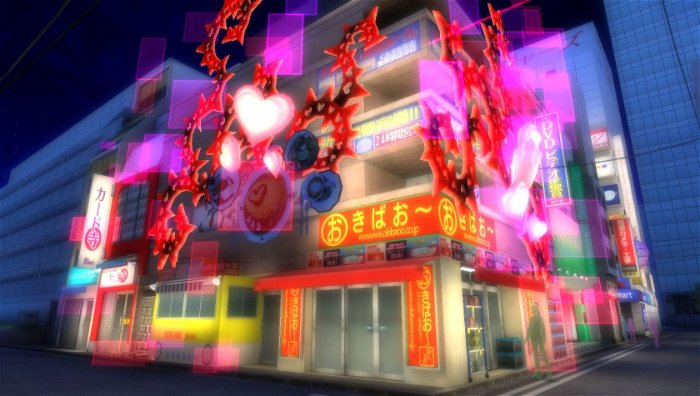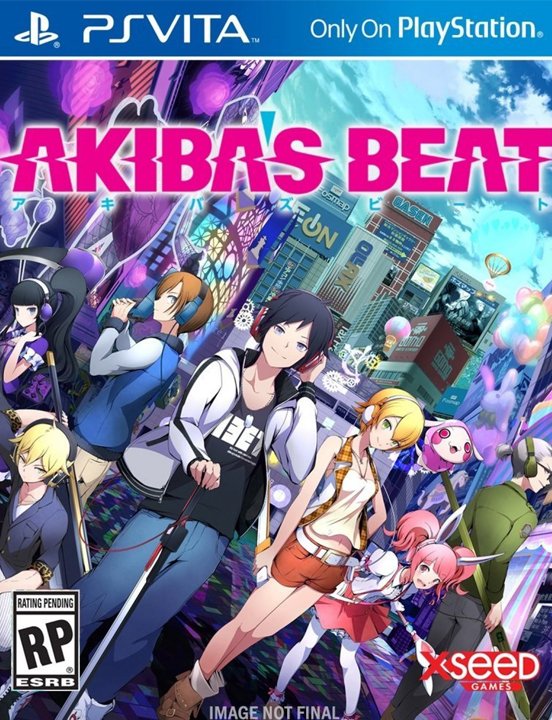Hayao Miyazaki once said of the anime industry “It’s produced by humans who can’t stand looking at other humans. That’s why the industry is full of otaku.” Miyazaki’s statement was a critique of anime’s lack of humanity and absence of understanding how the real world works. To him, anime is being made by people who’d been raised on anime was detrimental to the art form as a whole. The same can be said, I feel, of games heavily influenced by anime. Ever since Compile Heart realized it could recycle the same ideas for a decade and Senran Kagura started doing gangbusters, it became clear that anime games were content in being uncritical otaku bait. Slap enough cute girls with eyes that rival their cleavage in circumference on something, and it’ll sell. While this might seem like a dour way to open a review of Akiba’s Beat, it’s actually the most appropriate way I can think of. Because in a world of waifu simulators, Acquire’s latest is a scathing criticism of otaku culture and the cultish behavior it inspires.
This isn’t a happy accident, or me reading too much into the game. The game’s director, Kohta Takano, has explicitly stated that Akiba’s Beat is preoccupied with critiquing people who get too attached to their idealized versions of their own fandoms. Everywhere one looks throughout the game’s surprisingly nuanced narrative, it’s obvious. The protagonist is an emotionally stunted man-child who revels in his self-destructive lifestyle. Idol singers fend off leering old men who go into debt buying their albums. Maid fetishists stalk employees of maid cafes who feel pressured to never break character, lest they lose customers and their jobs. Takano’s version of otakudom is far from the sugarcoated wank often seen in something like Sword Art Online or No Game No Life. It’s much more in line with something like Welcome to the NHK—a simultaneous homage and takedown of otaku culture. There’s a reason that, unlike the game’s predecessors, Akiba’s Beat doesn’t feature any corporate sponsorship—because it’s deliberately biting the hands that have fed it, and it’s a more valuable work of art for that.

The way Akiba’s Trip deals with otaku deluding themselves is through the idea of Delusionscapes—dungeons built around a certain theme. These dungeons are the result of one person’s—cheekily known as Delusers—delusions spilling over into reality and manifesting into a physical reality. The theming of these dungeons is far-reaching and always humorous, with a personal favourite being the deliberately edgy, grimdark Puberternity dungeon. Taking a paging out of Persona’s book, players have to guide a motley crew of characters through these clever dungeons and fight the Phantasm at the center. Doing these destroys the Delusionscape entirely and, in theory, erases the memory of everyone involved with the delusion. There are special cases, though, and players will often find allies in these former Delusers.
Finding allies is what underpins the cynical nature of Akiba’s Beat’s satire. While it is an unabashed criticism of something that creators clearly know a lot about and have some affinity for, it’s also a poignant story of unlikely friendship. In many ways, it’s a spiritual successor in both tone and style to cult gem The World Ends With You—a tale of stylish loners finding meaning in their lives through each other and growing up through their newfound friendships. This is accomplished without the aid of shoehorned relationship mechanics and done entirely through good writing, deep characterization, and a narrative that feels written by somebody who’s actually interacted with another human being before. It’s a game where I became invested in the characters without the game playing on cheap sympathy or shock value, and that’s an increasing rarity not only in RPGs, but in video games in general. I appreciate both Akiba’s Beat’s willingness to treat its audience like adults and its heartfelt sincerity. And, as an aside, I appreciate its female characters being more than one-dimensional eye candy with watermelon breasts.

It also should be stated that Akiba’s Beat has one of the best translations in recent memory. Many people insist that anything less than complete faithfulness when translating a game is tantamount to censorship. But as we’ve seen with Persona 5’s notoriously clumsy translation, transliteration is a poor substitute for a good localization. And a good localization is exactly what’s on display here, with biting jokes that hit hard, Western references that range from Resident Evil 4 to Ghostbusters, and cheeky puns that continually one-up each other throughout the entire experience. When you sacrifice entertainment value for complete faithfulness, you’re alienating a wider audience and courting a smaller audience who revel in understanding quirky Japanese humour. That’s a questionable decision, I feel, and I’m glad Akiba’s Beat doesn’t do that. It’s one of the rare games that tries to be funny and doesn’t feel forced. That said, there’s enough quirky nerd humour here to keep those “in the know” happy, making it a sort of “best of both worlds” situation. It’s just good across the board, really, and a standard other that localized games should aspire to.
The gameplay’s nothing to sneeze at, either. Dungeon-crawling is a blast, with Delusionscapes becoming varied in their design and layouts. They’re a joy to explore, with branching paths that don’t lead the player in blatantly telegraphed directions. When in combat, players can expect something the lines of the real-time action of the Tales series, albeit with some fun mechanical quirks. For starters, combos are limited to a set amount of hits that can be modified with gear. This adds a certain rhythm to the combat, where players do their damage, then dodge out of the way. Getting off combos and using specials, builds up a meter which has two phases—a short high-strength phase that, once activated, unlocks the longer high-strength phase. This longer phase triggers a vocal music track and restricts the limit on combos, meaning that players can wail on bad guys with an unlimited wombo combo as a J-Pop singer belts out a catchy song. It’s a system that’s just deep enough to not feel repetitious and just easy enough to not be overwhelming, resulting in a title that’s both a good introduction and a fun title for veterans.

There’s also a novel gear system that’s easy to navigate but complex enough to allow room for experimentation. On top of traditional armour sets found in other RPGs, there are two other major systems in place—PC-building and trading cards. Every character has different parts of a gaming PC assigned to them, from GPUs to CPUs, and these can be customized with different components found in various shops. Depending on the character, players use their best judgment to stat out each party member, with these components allowing for more combos, stronger magic, et cetera. Adding another layer of depth is the fictitious VanFan trading card game. Players buy packs of trading cards from an adorable black market vendor, then affix obtained cards to a character. Separating these cards are a mathematical sign, like multiplication or division symbols. What this essentially boils down to is different combinations of cards yielding different effects, from attack boosts to elemental buffs to just about any stat one can imagine. These can be ignored entirely, dabbled in, or completely engaged with—it’s only as deep as you want it to be. That’s the beauty of both these systems to me, really, and represent what I like best about Akiba’s Beat’s gameplay. Practically anyone can play it, of any skill level, and find something to love.
What some people may not love, though, are the visuals. It’s sort of an eye of the beholder situation, in my opinion, because I was sufficiently impressed with the excellent character designs and the aesthetics of every dungeon. However, there was a point that my housemate walked by and remarked, “wow, those graphics are terrible.” It’s true that there’s not a lot of detailed texture work here, and that it’s the furthest thing from a lifelike game. But it sure is a stylish one, with a unifying series of design choices that make for something that I personally don’t think comes anywhere close to ugly. It makes careful use of vibrant primary and bright neon colours to create an atmosphere that ultimately wins over its lack of graphical fidelity. So, yes, it’s no Horizon: Zero Dawn, but it definitely has more of a memorable art direction that a lot of other titles. And as this year’s The Legend of Zelda: Breath of the Wild and Nier: Automata have shown us, that goes a long way when competing against games with bigger budgets.

I’m also a big fan of the soundtrack, which evokes the jazzy techno vibes of Persona 4 and 5 without feeling derivative, and hosts a great deal of excellent vocal tracks to boot. Any game with ClariS songs in it can’t be bad in the music department, really, and Akiba’s Beat is certainly a winner in my book.
The whole game is a winner, really, as far as I’m concerned. I’ve been very vocal in my disdain for the watered-down nature of recent RPGs, and in the blatant pandering found in games with anime-inspired aesthetics. Akiba’s Beat is an antithesis to both these things. It’s a simple RPG with enough depth to keep players hooked, and one that doesn’t handhold players for hours on end. It has a narrative that’s actually trying to say something, as opposed to being designed to make its audience feel precious and uncritical. It’s the Persona sequel I wanted, and the World Ends With You successor I’ve dreamed of. Tied together by stylish design choices, a catchy soundtrack, and a stellar translation, Akiba’s Beat is a great game, through and through, and something that any genre fan should check out.






